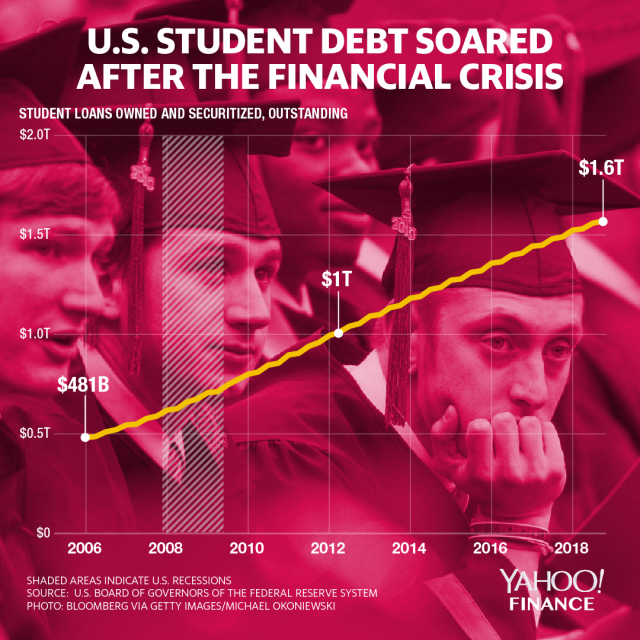Coronavirus student loan relief: Education Department says borrowers can ask for a payment pause
Student loan borrowers adversely affected by the coronavirus, or COVID-19, can officially get some relief on their debt if they request it, according to new details announced on Friday by the Education Department (ED).
Education Secretary Betsy DeVos directed all federal student loan servicers to grant “administrative forbearance” to any borrower with federal loans for at least two months, if they request one. Forbearance will be in effect for “at least 60 days” starting March 13. Documentation is not required.
“This will allow borrowers to temporarily stop their payments without worrying about accruing interest,” the department stated.
Furthermore, according to the department, all borrowers who have federal student loans will see their interest rates automatically drop to 0% “for a period of at least 60 days.”
“These are anxious times, particularly for students and families whose educations, careers, and lives have been disrupted,” DeVos stated in a press release. “Right now, everyone should be focused on staying safe and healthy, not worrying about their student loan balance growing.”

If borrowers are more than 31 days delinquent on their student loans as of March 13, or becomes delinquent, their payments are now automatically suspended — possibly coming as a massive relief to those who are having cash flow issues as unemployment rises.
According to the department’s most recent quarterly data, more than 3.2 million federal loans are more than 31 days delinquent. 7.7 million are in default.
For those who are still able to make payments, or are on a loan forgiveness track like Public Service Loan Forgiveness, that money will go towards the principal and no new interest will accrue. And if a borrower’s income was reduced or affected, ED asks these individuals to contact their loan servicer to discuss lowering the monthly payment.
Transition back into repayments a challenge
There are more than 43 million Americans with $1.5 trillion in student loan debt, with $1.3 trillion of that total pile being federal loans. The average interest rate on federal student loans are between 4.53% and 7.08%.
Massachusetts Senator Elizabeth Warren pushed DeVos to do more. On Thursday, Warren and several other Democratic senators introduced a broader student debt relief response, pushing for ED to not just make payments on behalf of students until the emergency period is over, but to also pay off $10,000 per borrower.
This still isn't good enough. We need to #cancelstudentdebt payments during this emergency, not pause them. And the federal government should cancel at least $10,000 for all student borrowers to help families & our economy. https://t.co/druvoPv96n
— Elizabeth Warren (@SenWarren) March 20, 2020
Consumer advocates said that the move wasn’t doing enough to help borrowers.
“We have heard from hundreds of people who are stuck on hold for hours and hung up on by these companies, and the lucky few who can get through are told that companies are waiting for guidance from Betsy DeVos’ Department of Education,” StudentDebtCrisis.org’s Cody Hounanian said in a statement.
And once the dust settles from this crisis, there’s a bigger problem at hand.
“Pausing payments ultimately leaves borrowers worse off,” Student Borrower Protection Center’s Mike Pierce said in a statement.
For one, making borrowers hit pause on their payments will “increase student loan defaults down the road,” given the department’s track record of managing another similar program, Pierce argued further in a blog post.

When a natural disaster hits, the same type of forbearance is offered to borrowers by loan servicers. And the organization’s research from that experience shows that borrowers struggle to get on track with their loans after being forced into forbearance, for many reasons.
“Once this crisis has abated, how do we successfully get borrowers back into successfully making loan payments?” Justin Draeger, President and CEO of the National Association of Student Financial Aid Administrators, told Yahoo Finance. “Because this was a lot of change, and if we think that this was going to go 100% according to plan, I just think this could be a bumpy ride for borrowers. So we need to be thinking about how we smooth these transitions.”
Instead, Pierce says that ED should make those repayments until borrowers get back on their feet.
“Flipping light switches on and off might be easy from a federal policy perspective,” Draeger added. “But from a borrower’s perspective it’s very confusing.”
—
Aarthi is a writer for Yahoo Finance. She can be reached at aarthi@yahoofinance.com. Follow her on Twitter @aarthiswami.
Read more:
Senate Democrats: Cancel student loan payments and $10,000 in debt amid coronavirus
How one startup is helping student loan borrowers navigate the coronavirus
Read the latest financial and business news from Yahoo Finance
Follow Yahoo Finance on Twitter, Facebook, Instagram, Flipboard, SmartNews, LinkedIn, YouTube, and reddit.

 Yahoo Finance
Yahoo Finance 
